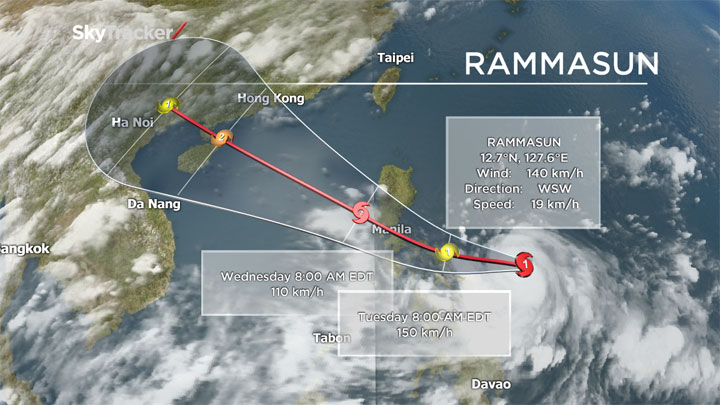MANILA, Philippines – The Philippines braced for possible floods and landslides as a tropical storm continued to strengthen on Monday as it approached the country’s eastern seaboard.

Tropical Storm Rammasun was expected to intensify into a typhoon before making landfall Tuesday morning in Albay province, the government’s weather bureau said.
Albay, about 340 kilometres southeast of Manila, is a disaster-prone province where mudslides from Mayon, the country’s most active volcano, buried entire villages in 2006 and left about 1,600 people dead and missing.
READ MORE: Powerful typhoon pounds Japan’s Okinawa islands
Rammasun, locally named Glenda, was about 500 km east of eastern Legazpi city as of Monday afternoon, packing sustained winds of 139 km/h and gusts of up to 140 km/h. It entered Philippine territory on Sunday while still over the Pacific Ocean.
Alexander Pama, executive director of the National Disaster Risk Reduction and Management Council, said the council’s field offices in at least seven regions, including Metropolitan Manila, had been put on alert for landslides and flash floods.
“Our initial assessment is that there is not much on the wind. What we are wary about are landslides, flooding,” Pama said.
READ MORE: WATCH – Soccer star David Beckham visits Typhoon-hit Tacloban
Schools suspended classes Monday afternoon in some areas, including Manila, the capital. Local officials urged sea vessels not to sail in the storm’s path, readied relief goods and prepared for the possible evacuation of residents, especially in flood- and landslide-prone areas.
Rammasun’s impact is expected to be felt in metropolitan Manila starting Tuesday and will be over the capital by early Wednesday before moving into the South China Sea through either Bataan or Zambales province in the northwest, forecasters said. It is expected to be out of Philippine territory by Thursday, possibly moving toward southern China.
Central Philippine provinces have not yet fully recovered from the massive devastation caused by Typhoon Haiyan last November. Haiyan’s strong winds and tsunami-like storm surges flattened towns, leaving at least 6,300 people dead and more than 1,000 missing.


Comments